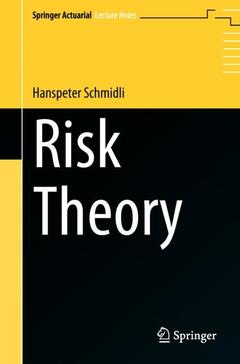Risk Theory, 1st ed. 2017 Springer Actuarial Lecture Notes Series
Auteur : Schmidli Hanspeter

This book provides an overview of classical actuarial techniques, including material that is not readily accessible elsewhere such as the Ammeter risk model and the Markov-modulated risk model. Other topics covered include utility theory, credibility theory, claims reserving and ruin theory. The author treats both theoretical and practical aspects and also discusses links to Solvency II.
Written by one of the leading experts in the field, these lecture notes serve as a valuable introduction to some of the most frequently used methods in non-life insurance. They will be of particular interest to graduate students, researchers and practitioners in insurance, finance and risk management.
Hanspeter Schmidli is Professor of Stochastics and Actuarial Mathematics at the University of Cologne, Germany. He is one of the leading experts in the areas of optimization in insurance and ruin theory. He has published intensively in risk theory and related fields, having (co-)authored Stochastic Control in Insurance (Springer, 2008) and Stochastic Processes for Insurance and Finance (Wiley, 1999), which continue to be widely used resources.
Date de parution : 04-2018
Ouvrage de 242 p.
15.5x23.5 cm
Thèmes de Risk Theory :
Mots-clés :
MSC 2010 91B30 60F10 60G42 60G44 60G51 60G55 60J10 60J25 60K05; MSC 2010 60K20 91B16; risk theory; ruin theory; utility theory; risk models; credibility; reserving; risk measures; change of measure; Lundberg exponent; subexponential distributions; approximations; renewal model; Markov modulated model



